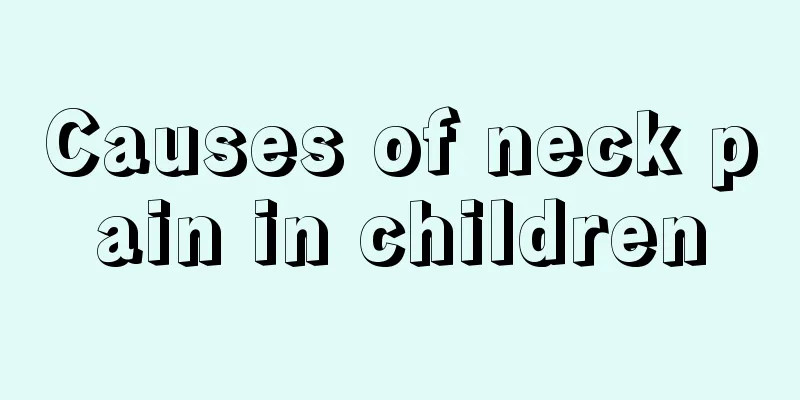Children's nosebleeds in hot weather

|
As the weather changes, the human body changes with it. Summer has arrived, and the hot weather has brought a series of problems. In summer, you will feel loss of appetite and heat all over your body, which will lead to symptoms such as nosebleeds and sores. Adults have a certain immune function and are not prone to illness, but children have weaker constitutions, so they should pay more attention to nosebleeds and seek timely treatment. Let’s take a look at the specific circumstances of children’s nosebleeds in hot weather. 1. Fragile nasal mucosa Because the climate is hot and dry in summer, children's nasal mucosa will become fragile and more prone to nosebleeds. 2. Caused by trauma Are your children naughty? Has your child ever had a nose injury? If the nose is injured, the child is more likely to have a nosebleed. 3. Pick your nose with your hands Young children with allergic rhinitis or colds will have itchy noses due to runny nose and nasal congestion, which may cause sneezing or picking their nostrils with their fingers, causing injury and bleeding to the fragile nasal mucosa. 4. Caused by other diseases Clinically, certain systemic diseases such as abnormal coagulation factors or tumors in the nasal cavity may also manifest themselves as "nosebleeds" in the early stages. If your baby often has nosebleeds for no apparent reason, it may be a sign of certain illnesses. I asked an expert from Haowang, and he said, "If you have frequent nosebleeds, you should go to the hospital for a check-up. Check your blood first. If there is no problem with the blood, go to the ENT department to see if there are any local factors." Therefore, it is better for parents to take their children to the hospital for a check-up to put their mind at ease. In addition, the editor here would like to suggest that parents must ensure their children's sleep. In some cases, children who do not get enough sleep are prone to nosebleeds. Now that we know the cause, how should we treat children’s nosebleeds at home in the summer? First of all, before this, the editor wants to say this: If a child suddenly has a nosebleed, the mother must not be scared by the sudden and large amount of blood flowing out. As long as the mother follows the correct approach, there will be no big problem. Then, keep the baby's head in a normal upright or slightly forward posture. Remember, the elderly used to tell us that we should tilt our head back when we have a nosebleed, but this is wrong! If you tilt your head back when you have a nosebleed, it may affect your breathing. Secondly, pinch the upper part of the nose on the bleeding side of the baby (the soft part of the nose) with your hand and press for about 5-10 minutes until the bleeding stops. (The other nostril that is not bleeding does not need to be compressed and can maintain normal breathing.) If the bleeding cannot be stopped, you must go to the hospital in time to find out the cause and receive timely treatment. We have talked about the treatment methods for children's nosebleeds. In fact, the best treatment is prevention. Let’s talk about the prevention of children’s nosebleeds. 1. In the hot summer, for children with a history of nosebleeds, families should have chloramphenicol eye ointment available, which can be applied evenly in the nasal cavity every day to moisturize the nasal mucosa. 2. Correct the child's picky eating habits, encourage him to drink more water, eat more vegetables, and arrange his diet reasonably and scientifically. 3. If children have difficulty breathing through their nose at night, you can use furosemide to moisten the nose, but never pick the nose. 4. Once nose bleeding occurs, you can use clean cotton wool to fill the nasal cavity to stop the bleeding. If there is no cotton wool, you can also use your fingers to press the sides of the nose for 5 minutes. 5. Let the child with nosebleed lower his head (note, not raise his head) and raise his upper limbs to increase the amount of blood returning to the heart in the superior vena cava, thereby reducing the blood supply to the nasal cavity to achieve the purpose of stopping bleeding. 6. Apply a cold towel to the nose to constrict the nasal blood vessels. Below, the editor recommends some recipes that children can eat when they have nosebleeds. Let’s take a look. Crucian carp gypsum stewed tofu 1 crucian carp weighing about 150 grams, 200 grams of tofu, and 30 grams of gypsum. After slaughtering and cleaning the fish, put it into the pot together with the tofu and gypsum, add appropriate amount of water and simmer for 1 hour. Season with salt and it is ready to eat. Young children can only drink the soup without eating the residue to prevent fish bones from choking in the throat. It has the effects of clearing lung heat, reducing stomach fire and stopping nosebleeds. Shengdi Ergen Drink Take 30g each of fresh Rehmannia glutinosa, fresh Imperata cylindrica root and 50g of fresh Phragmites australis, decocted in water, 1 dose per day instead of tea, for 7-10 days, it can clear away heat, cool blood and stop bleeding. |
<<: Can eight-month-old babies drink yogurt?
>>: Causes of fever in children on hot days
Recommend
What are some recipes that help children grow?
Children's growth and development cannot be s...
What should I do if my baby has a blocked nose when sleeping at night?
I believe that in life many parents will encounte...
What are the precautions for appendicitis surgery in children?
Many children nowadays may suffer from pediatric ...
How to treat sinusitis in a two-year-old baby
Adults are very anxious when children get a littl...
Why does a child cough and have a thick white tongue coating?
Children's physical resistance is usually poo...
Can children drink fresh coconut milk?
Fresh coconut juice is fresher and more nutritiou...
The harm of waist stool to baby
Many things and events have two sides, that is, t...
What are the symptoms of indigestion in babies?
Nowadays, many children like to eat snacks, and m...
What are the diets for children with autumn diarrhea?
Many people who have been parents may know that d...
Side effects of radiography in infants
Imaging technology is a medical technology that i...
Children often do these to prevent myopia
Myopia among children is a very common phenomenon...
What should I do if my child has bloating?
If some children have problems, then it is necess...
What to do if baby spits up milk from nose
We all know that some organs in the baby's bo...
What to do if a child gets a nosebleed after an adult hits his ear
In life, it is very common for children to be pun...
Is it good for children to drink lemon honey water?
Everyone knows that lemon honey water is a drink ...









